|
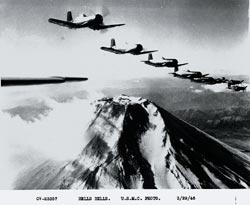 When the war flared in Korea, the Corsairs were ready. Assigned primarily to the low altitude, fighter-bomber phase of the action, they were on familiar ground flying close air support missions in support of ground troops, a function they had helped pioneer in WW II. When the war flared in Korea, the Corsairs were ready. Assigned primarily to the low altitude, fighter-bomber phase of the action, they were on familiar ground flying close air support missions in support of ground troops, a function they had helped pioneer in WW II.
Ground Marines in Korea quickly came to accept the Corsair as a standard weapon. Corsairs operated from both carriers and fixed bases in support of infantry. The F4U-5, F4U-5N, F4U-5P, and the F4U-5NL versions of the Corsair came available during the five short years between WW II and Korea. The AU-1, the attack version of the Corsair, which was developed during the Korean conflict based on the ground support lessons being learned, became available in 1952. The AU-1 joined six other models of the Corsair in the Korean fighting. All versions of the Corsair proved their worth in the hands of an outstanding group of Navy and Marine aviators.
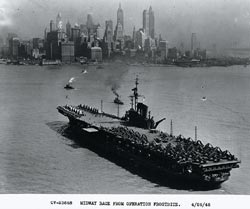 The North Korean and Chinese enemy soon learned that the appearance of an aircraft with a distinctive bent wing configuration meant 50 caliber and 20 millimeter rounds, bombs, rockets and Napalm in their midst with devastating accuracy, They were also to learn that being in close proximity to American troops offered no protection because the American flyers operated at point blank range! The Marines could call in air strikes within 50 yards of their position, knowing that their aerial comrades in the rock steady F4U would deliver with pinpoint accuracy. The winterized version, (F4U-5NL'.s), performed well in the frigid winters and the night fighter version, (F4U-5N's) hit enemy troops and convoys after dark. The North Korean and Chinese enemy soon learned that the appearance of an aircraft with a distinctive bent wing configuration meant 50 caliber and 20 millimeter rounds, bombs, rockets and Napalm in their midst with devastating accuracy, They were also to learn that being in close proximity to American troops offered no protection because the American flyers operated at point blank range! The Marines could call in air strikes within 50 yards of their position, knowing that their aerial comrades in the rock steady F4U would deliver with pinpoint accuracy. The winterized version, (F4U-5NL'.s), performed well in the frigid winters and the night fighter version, (F4U-5N's) hit enemy troops and convoys after dark.
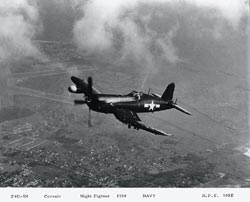 Although most of the Corsairs in Korea were late-type models, with more horsepower and firepower than WW II versions, some of the planes seeing action were like their pilots, veterans of the last war. A number of Corsairs aboard the Essex and Bon Homme Richard in Korean waters fought at Okinawa and in Tokyo raids. Although most of the Corsairs in Korea were late-type models, with more horsepower and firepower than WW II versions, some of the planes seeing action were like their pilots, veterans of the last war. A number of Corsairs aboard the Essex and Bon Homme Richard in Korean waters fought at Okinawa and in Tokyo raids.
In the first 10 months of the Korean war Corsairs accounted for 82 percent of all close support missions flown by the Navy and Marines. Marine Fighter Squadron 323, flying WW II type cannon equipped F4U-4B's, in 1952, set an effective combat record of 1,160 effective sorties in one month. Ninety-one sorties were flown in one day, with 100 percent availability recorded for the Corsairs. More than 120 tons of ordnance were dropped on the enemy in one day.
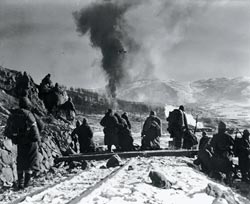 A Corsair flown by Marine Capt. Jessie G. Folmar shot down one of the highly-touted,Russian-built MIG-15's in September of 1952. Jumped by five of the fast jets, Folmar sent one of the MIG's down in flames before his own plane was hit and he baled out to safety. A Corsair flown by Marine Capt. Jessie G. Folmar shot down one of the highly-touted,Russian-built MIG-15's in September of 1952. Jumped by five of the fast jets, Folmar sent one of the MIG's down in flames before his own plane was hit and he baled out to safety.
A number of factors contribute to the value of the Corsairs in the job they did in Korea.
- Ability to carry an exceptionally heavy bomb and rocket load for a fighter. Records show that the Corsairs have carried as much as 5,000 pounds to their targets.
- Ability to stay on target for extended periods. Endurance of the plane was such that it could cover infantry troops for a length of time impossible for jets, which consume tremendous amounts of fuel.
- Ability to take punishment.
- Operational availability, Corsairs established an outstanding record of being available for combat when needed. Some Squadrons in Korea averaged as high as 95% availability.
After the Korean conflict was over in 1953, the F4U was gradually phased out of active service and placed in use with the Navy Reserve units. By mid 1957, the Corsair was no longer in the US Navy; however the F4U-7 Corsair was still in active service with the French Navy.
The F4U-7 was the last of the Corsairs. The F4U-7 was manufactured specifically for the French and to their requirements. In 1952 the French Navy took delivery of 94 F4U-7's. The French were extremely proud of their new Corsairs as it was the first new fighter they had purchased in many years. It was badly needed as they had been engaged in a war with French Indo China, then a French colony now known as Viet Nam since 1946 and needed all the help they could acquire. While the French war effort was not successful, the mighty bent-wing bird served admirably and was considered the "star of the action."
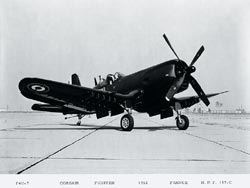 The French were availed still another opportunity to exploit the Corsair when they joined the British against Egypt during the 1956 Suez incident. The venerable Corsair served the French for still another eight years of sterling service and is fondly remembered by those who were involved in their operation One beautiful example of the F4U-7 still flies in England as part of the Duxford collection. Resplendent in French Navy markings, it is a star in numerous air shows performed each year. The French were availed still another opportunity to exploit the Corsair when they joined the British against Egypt during the 1956 Suez incident. The venerable Corsair served the French for still another eight years of sterling service and is fondly remembered by those who were involved in their operation One beautiful example of the F4U-7 still flies in England as part of the Duxford collection. Resplendent in French Navy markings, it is a star in numerous air shows performed each year.
Still another conflict was to provide the F4U with it's most unusual opportunity for combat. This was in South America with aircraft furnished to El Salvador and Honduras in 1951-1961, When war erupted between the two countries, it was Corsair against Corsair. Fortunately, the war was short lived but not before some Corsairs were shot down in aerial combat.
The most recent duty for the Corsair was simulated combat during the filming of the popular series Blacksheep Squadron which starred Robert Conrad. The film told the story of Pappy Boyington's VMF-214, and how they became the scourge of the Pacific as they methodically destroyed large numbers of Japanese aircraft with little loss to themselves.
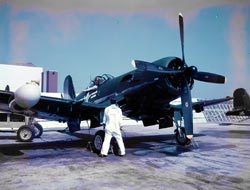 To this day, the "Hog," as it was affectionately called, is still a favorite, whether seen as a static display or in an exciting air show. Residents of the Dallas-Ft Worth area are often treated to the sight of the Confederate Air Force F4U flown regularly by the company's former Chairman of the Board and CEO, Paul Thayer or former Chief Test Pilot, John Conrad. To this day, the "Hog," as it was affectionately called, is still a favorite, whether seen as a static display or in an exciting air show. Residents of the Dallas-Ft Worth area are often treated to the sight of the Confederate Air Force F4U flown regularly by the company's former Chairman of the Board and CEO, Paul Thayer or former Chief Test Pilot, John Conrad.
More F4U:
Operation Summary WWII
WWII Record
WWII Corsair Aces
Production
Lindbergh, Clark and a 4000lb Bomb Load
Operation Summary Post WWII
|